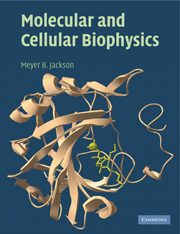Book contents
- Frontmatter
- Contents
- Preface
- Acknowledgements
- Chapter 1 Global transitions in proteins
- Chapter 2 Molecular forces in biological structures
- Chapter 3 Conformations of macromolecules
- Chapter 4 Molecular associations
- Chapter 5 Allosteric interactions
- Chapter 6 Diffusion and Brownian motion
- Chapter 7 Fundamental rate processes
- Chapter 8 Association kinetics
- Chapter 9 Multi-state kinetics
- Chapter 10 Enzyme catalysis
- Chapter 11 Ions and counterions
- Chapter 12 Fluctuations
- Chapter 13 Ion permeation and membrane potential
- Chapter 14 Ion permeation and channel structure
- Chapter 15 Cable theory
- Chapter 16 Action potentials
- Appendix 1 Expansions and series
- Appendix 2 Matrix algebra
- Appendix 3 Fourier analysis
- Appendix 4 Gaussian integrals
- Appendix 5 Hyperbolic functions
- Appendix 6 Polar and spherical coordinates
- References
- Index
Chapter 10 - Enzyme catalysis
Published online by Cambridge University Press: 24 May 2010
- Frontmatter
- Contents
- Preface
- Acknowledgements
- Chapter 1 Global transitions in proteins
- Chapter 2 Molecular forces in biological structures
- Chapter 3 Conformations of macromolecules
- Chapter 4 Molecular associations
- Chapter 5 Allosteric interactions
- Chapter 6 Diffusion and Brownian motion
- Chapter 7 Fundamental rate processes
- Chapter 8 Association kinetics
- Chapter 9 Multi-state kinetics
- Chapter 10 Enzyme catalysis
- Chapter 11 Ions and counterions
- Chapter 12 Fluctuations
- Chapter 13 Ion permeation and membrane potential
- Chapter 14 Ion permeation and channel structure
- Chapter 15 Cable theory
- Chapter 16 Action potentials
- Appendix 1 Expansions and series
- Appendix 2 Matrix algebra
- Appendix 3 Fourier analysis
- Appendix 4 Gaussian integrals
- Appendix 5 Hyperbolic functions
- Appendix 6 Polar and spherical coordinates
- References
- Index
Summary
How enzymes accelerate biochemical reactions is one of the oldest and most challenging problems in biophysics. An enzyme binds with high specificity to a substrate molecule, chemically modifies it, releases the product, and then repeats the cycle. Without the enzyme, the same chemical reaction can still take place, but at a vastly slower rate. The most impressive enzymatic accelerations approach 1020 (Miller and Wolfenden, 2002). A value in the region of 108–1012 is more typical, but that still represents a remarkable enhancement. Enzymes are responsible for virtually all of the metabolic chemistry in the biological world. However, there is another point worth mentioning. Nearly all enzymes are proteins (the exception is ribozymes – catalytic RNA), so a study of enzyme catalysis provides a window into the basic mechanics of proteins carrying out their functions. Enzyme catalysis provides excellent examples of how the structure and dynamics of proteins relate to their activity.
We know a great deal about the chemical mechanisms employed by enzymes. X-ray crystallography has given us atomic-level pictures of enzyme–substrate complexes in which many important contacts are evident. Some of these contacts are strictly for binding, and enable the recognition of specific substrates. The binding of substrate is the first step of enzyme catalysis, and this provides an important application of the physics of molecular associations (Chapter 4). The next step is the chemical reaction, and this brings the rate processes of Chapter 7 into the picture.
- Type
- Chapter
- Information
- Molecular and Cellular Biophysics , pp. 248 - 275Publisher: Cambridge University PressPrint publication year: 2006



